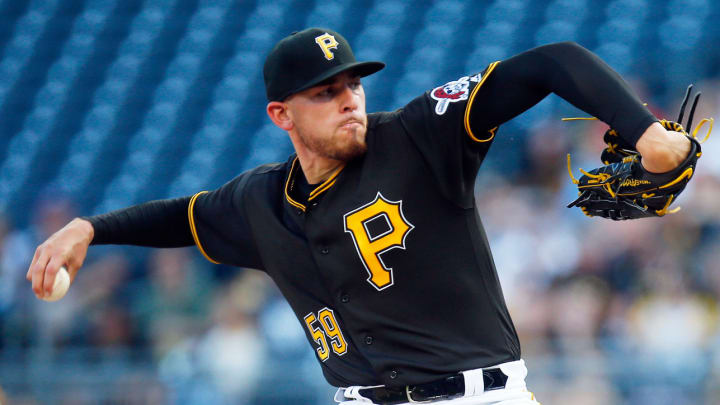Joe Musgrove Will Be a Staple of the Pirates Rotation If He Can Command His Cutter

There is no shortage of mound intrigue on Wednesday’s MLB slate. Max Scherzer, Corey Kluber and Luis Severino are all scheduled to start, the latter against the Astros. He’ll face off with Dallas Keuchel in the best head-to-head matchup of the day. Shohei Ohtani will take the ball for the Angels, James Paxton will toe the rubber for the Mariners, and Alex Reyes will make his 2018 debut. You could pin Wednesday’s schedule to a wall, close your eyes, throw a dart at it, and hit a game with at least one great starting pitcher taking the ball.
The sheer volume of top-of-the-rotation pitchers in action Wednesday will invariably lead to a few others worthy of attention getting overlooked. With that in mind, make sure you have the Cubs-Pirates game in Pittsburgh on your radar. Joe Musgrove may not yet, or ever, be a name brand like Scherzer or Kluber, and he may not have the prospect hype of someone like Reyes, but he is nearly every bit as intriguing as anyone else taking the mound on Wednesday.
Musgrove made his Pirates debut last week under trying circumstances. There was always going to be a heavy burden on Musgrove’s shoulders after he was the centerpiece of the deal that sent Gerrit Cole, one of the symbols of the Pirates’ renaissance, to Houston. Then, while Musgrove spent the first two months of the season on the DL with a shoulder issue, Cole turned into the ace he never quite became in Pittsburgh, all while helping lead the Astros to the top of the AL West. That’s a seemingly impossible context for any pitcher, let alone a 25-year-old with fewer than 200 innings under his belt in the majors.
Musgrove answered the bell, bringing a measure of solace to Pirates fans, not to mention GM Neal Huntington, who have had to watch Cole morph into an AL Cy Young contender. He tossed seven shutout innings against the Cardinals, allowing five hits while striking out seven and walking none. He needed just 67 pitches to get through his seven innings, throwing 50 of them for strikes. Musgrove showed off his entire repertoire, with his four-seamer averaging 95.7 mph, and he generated seven whiffs on 34 swings.
There aren’t any sweeping conclusions to draw off one outing for any pitcher, even less so for one making his 26th career start. All we know for certain is that Musgrove threw the ball well that day, and that he has ample potential in both the short and long term. Still, we can highlight interesting traits of one start, especially when they differ dramatically from a pitcher’s track record, and wonder whether they’re the start of something new. That’s exactly what we’re going to do in the rest of this column.
Among Musgrove’s 67 pitches against the Cardinals were 16 cutters. The offering accounted for 23.9% of his pitch count, second to his four-seamer. Musgrove has always thrown a cutter, but it had just a 4.5% usage rate last season. Meanwhile, he threw his slider just nine times in his first start this season, good for a usage rate of 13.4%. Last year, it comprised 27.6% of his pitch total.
Cutters and sliders are cousins in a pitcher’s repertoire. They have similar movement and spin, making them ideal pitches to use in tandem. A cutter won’t break as much as a slider while having a higher velocity, typically about five or six mph. A cutter has more depth and tilt, making it a better chase pitch, and more likely to induce whiffs. The fact that they look the same but act differently makes them wonderful partners in the same way that two-seam fastballs and changeups are.
Here’s a standard Musgrove cutter in an 0–1 count against Jose Martinez.
And here’s the slider, giving us a good look at how the two differ.
See how the cutter stays more level whereas the slider dives when it gets into the hitting zone? The slider may seem a “better” pitch, in that it’s more capable of getting the swings like it did out of Kolten Wong for strike three, but both offerings are more effective with the other one as part of Musgrove’s arsenal.
Musgrove certainly isn’t going to go any further away from the slider than he did in his first start. Not only is it an effective pitch, but, after ditching his curveball, it’s the only breaking ball in his repertoire. In fact, the bet here is that we’ll see the usage rates for his cutter and slider only converge over time. Still, an increase in the cutter’s usage rate compared with last year makes a lot of sense for Musgrove, especially considering he’ll stick in the rotation this season after splitting his time as a starter and reliever in 2017.
We’ve merely scratched the surface of what Musgrove can be as a pitcher. He sits in the mid-90s, throws a filthy sinker, and a changeup that works in concert with both of his fastballs. It would be folly to go any further, though, given that he has made all of one start this season. This won’t be the last time we check in on him, however. And on a night where Scherzer, Kluber, Severino, Ohtani, Paxton and Reyes will all take the mound, you should find some screen time for Musgrove, as well.
